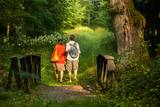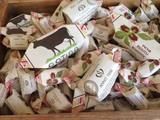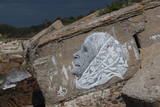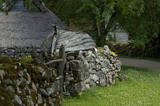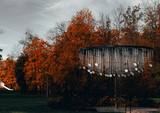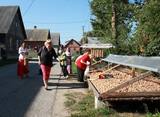| Nr | Name | Beschreibung |
|---|---|---|
|
Saimniecība piedāvā zirgu izjādes (ratos un mugurā), iespēja apskatīt dzīvniekus lauku sētā (zosis, vistas, truši, teliņi, kazas, aitas, suņi un kaķi). Pļavas ar ārstniecības augiem, mežs, dīķis, stārķu koks. Sarunas par dzīvi ar saimniekiem. Rīta rasas skaistuma procedūras, "varžu koris", tējas baudīšana seno ābeļu paēnā, ārstniecības augu vākšana kopā ar saimnieci. Telšu un piknika vietas (līdz 20 cilvēkiem). |
||
|
Im Park des Orellenhofs, der für seine großen Urbäume bekannt ist, deren Stämme mit dem lebenden und dem toten Holz vielen auch bereits vom Aussterben bedrohten Arten eine Heimstatt bieten, wurde ein Urbaumpfad eingerichtet. Im Park befindet sich das einzige in Lettland erhaltene Herrenhaus aus Holz vom Beginn des 18. Jh.
|
||
|
Labiekārtota (informācijas stendi, atpūtas vietas) un marķēta taka, kas ved apkārt Kokšu ezeru virknei, kurā ietilpst Zāļu, Dziļais un Dibena ezers. Iepazīstami mežu biotopi, dzīvnieki un to darbības pēdas. Iespējami trīs dažādi takas izziešanas varianti: 7 km, 4,5 km, 2,7 km. Maršrutu var braukt ar divriteni. Ietilpst Ziemeļvidzemes biosfēras rezervātā. |
||
|
Das erste Unternehmen, das 1957 die Produktion der beliebten Milch-Bonbons „Gotiņa“aufnahm. Hier kann man köstliche Bonbons erwerben und auch an einer Führung teilnehmen, der Inhaber des Unternehmens ist zugleich der Haupt- Bonbonmeister. |
||
|
Nördlichen Befestigungswerke, die an der Küste des baltischen Meeres liegen (teilweise abgespült), sind nur ein kleiner, jedoch ein beeindruckender Teil von dem einzigartigen Fortifikationssystem in Liepāja, das die Stadt im ganzen Umfang umgibt. Die unterirdischen Bunker der Befestigungswerke haben zwei Etagen und es lohnt sich sie in Begleitung des gebildeten Reiseführers von Karosta zu besichtigen (organisierte Exkursionen von Gefängnis in Karosta). Neben den Befestigungswerke liegt einen Autoparkplatz. Es lohnt sich beim Besuch der nördlichen Befestigungswerke die etwa 4 km lange Strecke entlang der Küste bis zu der nördlichen Mole von Liepāja zu gehen. Hier kann man die zwei Küstenschützbatterien an der Meeresküste und im Meer, als auch sehr beeindruckende Ansichten sehen.
|
||
|
Das Dorf Koguva an der Westküste der Insel Muhu ist ein hervorragendes Beispiel für die estnischen Bauernarchitektur. Die relativ gut erhaltenen Bauerngebäuden und Steinzaunen liegen alle unter Baudenkmalschutz. Im Museum von Muhu kann man einen ehemaligen reichen Strandhof Tooma erkundigen, der vor allem als Geburtsort des Schriftstellers Juhan Smuul bekannt. Hier sind auch eine alte Dorfschule und Textilausstellung. |
||
|
К северо-востоку от Мазирбской лютеранской церкви – в полемежду храмом и домом «Пакални» видны два чумных камня. На поверхности бóльшего был высечен (сейчас стерся) текст о ливах, которых одолел король Швеции Карл IX и чума. Сбоку на большой камень опирается второй (самый маленький) чумной камень, который в свое время был установлен у близлежащих домов. Стертый текст рассказывал об армиях, ходивших по Курземе, о голоде и чуме. Третий – Большой чумной камень находится заМазирбским имением священника. Высеченный на нем текст (еще немного просматривается) повествует будущим поколениям о местном священнике (умер во время чумы) и о создании пастората в Сикрагсе. Одновременно камень является памятником шести пасторам обширной окрестной общины. Все три камня повествуют о Большой эпидемии чумы 1710 года, и тексты высечены на них в период с 1711 по 1734 год. |
||
|
The viewing tower was built quite recently. At its foot is a location for relaxation. It offers a good view of one of the curves of the Daugava River – the Adamova curve. A bit beyond is the Curves of Daugava Nature Park. Along the tower is the “Saulkrasti Trail” bicycle route.
|
||
|
The farm produces homemade wine made of rhubarb, birch juice and apples. Tour the winemaking facilities and examine the process. You can taste and purchase products. |
||
|
Als eine Siedlung ist Balvi zum ersten Mal 1224 erwähnt worden. In der Jahrhundertwende 19.-20. Jh. bildete sich Balvi als das Zentrum des Landgutes und der Gemeinde zu einer größeren Siedlung heraus. Während der lettischen Freiheitskämpfe im Jahr 1919 wurde in Balvi das Partisanenregiment der Region Latgale gebildet. Im Jahr 1926 hat Balvi die Ortschaftsrechte, aber im Jahr 1928 – die Stadtrechte erworben. Während des Zweiten Weltkriegs hat die deutsche Armee beim Zurückziehen fast die ganze Stadt niedergebrannt. Die Einwohner von Balvi sind darauf stolz, dass hier die Sonne drei Minuten früher als in Riga aufgeht. Das Zentrum der Stadt hat sich in den letzten Jahren sehr stark verändert. |
||
|
Iespēja ielūkoties audējas, rokdarbnieces, ekoloģisko rotaļlietu radītājas, tekstilmākslinieces projekta “100 deči Latvijai” autores Anneles Slišānes senajās Latgales lauku mājās.
|
||
|
Im bäuerlichen Betrieb beschäftigt man schon mehr als 20 Jahre mit der Herstellung von Käse. Es wird die Milch der eigenen Kühe verwendet. Hier hergestellte Käsespezialitäten kann man auf den größten Märkten und Jahrmärkten Lettlands kaufen. |
||
|
Dvietes un netāli esošais Skuķu ezeri ir vieni no teritorijas grūti pieejamajiem palieņu ezeriem – lielākie šāda tipa
ezeri Latvijā. Palu laikā pārplūst, savienojoties vienā lielā ūdenskrātuvē.
|
||
|
Am Ufer von Peipussee befinden sich dicht nacheinander Dörfer, die vor Jahrhunderte von den Altgläubigen, die aus Russland entflohen haben, bewohnt wurden - Kolkja, Kasepää und Varnja. |
||
|
Dabas liegums atrodas dienvidaustrumos no Lubāna ezera un tas veidots purva un meža biotopu un tajos esošo sugu aizsardzībai. Gar teritorijas ziemeļu robežu iet Nagļu - Degumnieku ceļš (iekļaujas kopējā Lubāna dambju sistēmā), pa kuru apkārt Lubāna ezeram izveidots velomaršruts. Tas nozīmē, ka teritoriju var aplūkot arī "no malas", netraucējot tās dabiskās norises. Teritorija ietilpst arī Lubāna mitrāja kompleksā.
|
||
|
Einer der größten Weingärten in Lettland mit über 50 Rebsorten. Bei den angebotenen Führungen erzählt der Winzer über den Anbau von Wein und konsultiert bei Fragen zum Thema. Weiterhin gibt es Verkostungen und man kann Rebstöcke kaufen. |
||
|
Das Café befindet sich im historischen Zentrum von Tukums, am Freiheitsplatz. Lettische Küche: Graupengrütze. |
||
|
Tillu ist ein Hauscafé, das sich im Laden des Bauernbetriebs Põlva befindet. Hier herrscht ein bisschen eine eklektische, ungezwungene Atmosphäre vor, aber gleichzeitig ist dieser Ort warm und gemütlich. Jeden Tag werden Brötchen und gefüllte Teigtaschen gebacken. Deshalb kann man hier immer angenehme Gerüche riechen. |
||
|
This venue organises seminars, courses and activities related to Latvian holidays and family celebrations. There are master’s classes about culinary heritage in
|
||
|
As you travel from Kandava to Sabile, you will find a parking lot on the right side of the road. From there, there are steps to a viewing area on the highest hill in the Abava Ancient River Valley – Greiļi Hill. This offers a wonderful view of the ancient river valley and the local mosaic of meadows and forests. The landscape is enriched by the Imula and Amula valleys that are on the other side of the ancient river valley.
|
||

